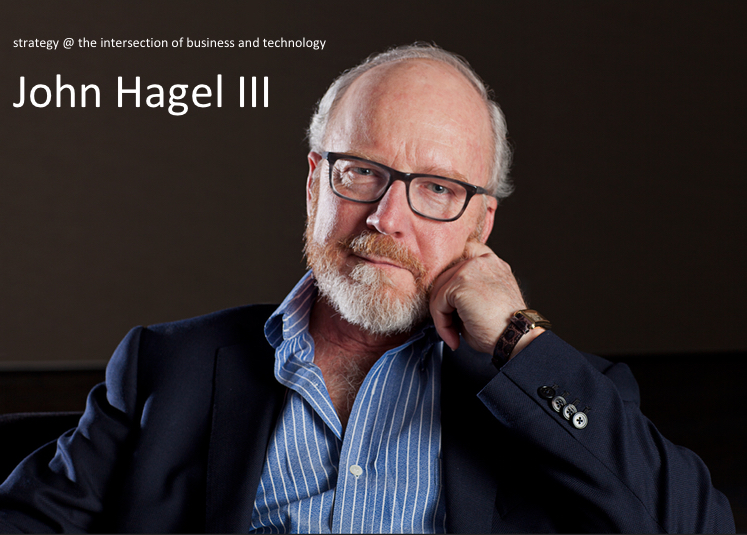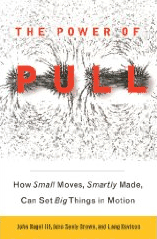
![]()
Speaking
I speak on
topics related to business, strategy and technology. From conceiving and implementing
FAST strategies to pragmatic technology approaches, I seek to challenge traditional
assumptions and help uncover simple, yet profitable solutions best suited to
your company's situation. Get details >>
Papers
- Moving
from Push to Pull - Emerging Models for Mobilizing Resources
(PDF)
John Hagel and John Seely Brown
- Capturing
the Real Value from Offshoring in Asia (PDF)
John Hagel
- The
Agile Dance of Architectures – Reframing IT Enabled Business Opportunities
(PDF)
John Hagel and John Seely Brown
- Overview
of Working Paper Series (PDF)
John Hagel and John Seely Brown
- Break
On Through to the Other Side: A Missing Link in Redefining the Enterprise
(PDF)
John Hagel and John Seely Brown
- The
Secret to Creating Value from Web Services Today: Start Simply (PDF)
John Hagel, John Seely Brown and Dennis Layton-Rodin
- Service
Grids: The Missing Link in Web Services (PDF)
John Hagel and John Seely Brown
- Some
Security Considerations for Service Grids (PDF)
Martin Milani and John Seely Brown
- Control
versus Trust: Mastering a Different Management Approach (PDF)
John Hagel and John Seely Brown
- Orchestrating
Business Processes - Harnessing the Value of Web Services Technology (PDF)
John Hagel and John Seely Brown
- Orchestrating
Loosely Coupled Business Processes: The Secret to Successful Collaboration
(PDF)
John Hagel, John Seely Brown and Scott Durchslag
Viewpoint
June
1, 2002
What
Business Are You Really In?
Martha Stewart vs. AOL
Like most things in life, the most difficult part of a blog is the beginning. Where to start? How about Martha Stewart and AOL Time Warner (AOL)? Why there? Well, they're in the news right now (ever notice how media companies have become the favorite subject of other media companies?) and I know a little bit about both (just enough to be dangerous).
A long time ago, I used to work for one of the early parents of AOL - Warner Communications (back when they used to own the wild and crazy videogame pioneer, Atari). I don't know Martha, but I have watched her from afar with growing admiration. The real reason to write about them is because they are both in the media business and yet they illustrate fundamentally different approaches. There may be some broader business lessons to learn.
Martha just had a book written about her (Martha, Inc.: The Incredible Story of Martha Stewart Living Omnimedia by Christopher Byron) - one that I expect she was not too happy to see published. The book acknowledges her business accomplishments, but focuses on her personal life. It does not paint a pretty picture. Whatever flaws she may have in her personal life, Martha Stewart represents a very different - and very promising - model for the media business of the future.
What are the elements?
- First, she has targeted a very clear audience - the homemaker seeking advice on how to make a better home.
- Second, she has taken a core set of content and systematically leveraged it across a broad range of media - books, magazines, television, and the Internet - to reach that audience. She has been very effective in expanding share of attention of the target audience.
- Third, she has smoothly expanded from content to merchandise and is steadily expanding her share of wallet of the target audience. Relying heavily on direct marketing catalogs and her web site, Martha has begun to develop detailed profiles of individual members of her audience and of their preferences and purchase histories.
- Fourth, she has used this clear audience focus and broad media and merchandise reach to develop a very strong brand. The brand is about the audience - Martha Stewart knows what you as homemakers (and, increasingly, you as individual homemakers) would find most useful and you can trust her to deliver the right mix of advice and products to make your efforts more successful.
Sounds a lot like what Disney did in its heyday before it lost its way. Even more than Disney, Martha Stewart Living Omnimedia, Inc. (MSO) has taken seriously the need to develop detailed profiles of individual audience members and to use that information to introduce audience members to helpful products and services.
Let's look at AOL
Time Warner in contrast. AOL represents a more conventional media
model. Even Disney has fallen under its spell.
- Size matters. Expand across as many media forms as possible, but don't worry about maintaining audience focus - that just limits efforts to get bigger.
- Content needs to own distribution channels and vice versa. This after all was the logic behind the original Time Inc. and Warner Communications merger. The same logic drove Time Warner into the arms of AOL.
- As the reach of the media company expands, focus on building the brands of individual media properties, rather than an overarching brand that will have a powerful hold on the audience.
Here's the problem. AOL lacks a distinctive identity. It is spread too thin. It has more difficulty building upon the success of one media property. It wrestles with conflicts: should it try to make its distribution channels (e.g., cable systems and online AOL service) more distinctive by providing exclusive access to its content or should it try to broaden the reach of its content to other channels?
Both MSO and AOL have suffered in the recent stock market. But here are some differences:
- AOL is making massive write-offs leading to large losses, while MSO remains profitable, even in the midst of a severe advertising downturn
- Investors have
more faith in MSO - it trades at a price/sales (ttm) ratio of 3.2, almost
50% better than AOL's 2.2 price/sales ratio
The lesson: size matters, but focus matters even more. Here are some specific steps AOL might take to create more focus:
- Divest the distribution business and retain the content business.
- Create audience segment business units to address specific audiences that are economically attractive and fit with some of AOL's existing properties - some natural examples: business executives, sports enthusiasts and teen-agers.
- Assign content businesses to report to specific audience segment business units (e.g., Sports Illustrated reporting the sports enthusiast business unit) or establish content businesses as shared services units (e.g., Warner Brothers movie studio) to support all the audience segments
- Build distinctive
overarching audience brands aggressively
Invest in businesses and skill sets to deepen database marketing capabilities - Acquire businesses
selectively to broaden share of attention and share of wallet within
priority audience segments
MSO is doing well but it can build even further on its current foundation:
- Build secondary
personalities and branded media properties to reduce the dependence
on one person for the brand
- Add more value
as a trusted advisor by helping to connect homemakers with an even
broader range of products and services - even if they don't carry
the Martha Stewart brand (see Net
Worth for more information on the "infomediary"
concept)
The lesson for everyone: decide what business you really are in (hint: it is probably not obvious - see "Unbundling the Corporation") and then design a growth strategy to reinforce, rather than dilute, that business focus.
register for site updates >>
register for site updates >>
Blogs
- The Big Shift (HBR)
- EdgePerspectives blog
Books

The
Power of Pull: How Small Moves, Smartly Made, Can Set Big Things in Motion
by John Hagel III, John Seely Brown, and Lang Davison
ALSO

The
Only Sustainable Edge: Why Business Strategy Depends on Productive Friction
and Dynamic Specialization
by John Hagel III and John Seely Brown
- Out
of the Box: Strategies for Achieving Profits Today and Growth Tomorrow through
Web Services
by John Hagel III
- Net
Worth: Shaping Markets When Customers Make the Rules
by John Hagel, III and Marc Singer
- Net
Gain: Expanding Markets through Virtual Communities
By John Hagel, III and Arthur G. Armstrong
Deloitte
ongoing
research:
The 2009 Shift Index
The Big Shift Index: Uncovering the Emerging Logic of Deep Change
www.edgeperspectives.com
Cloud Computing working papers
BusinessWeek
The Next Wave of Open Innovation
April, 2009
Does the Experience Curve Matter Today?
April, 2009
Peer-to-Patent: A System for Increasing Transparency
March, 2009
How World of Warcraft Promotes Innovation
January, 2009
Harrah's New Twist on Prediction Markets
December, 2008
Innovation for Hard Times
November 2008
How SAP Seeds Innovation
July 2008
Student Activism Can Change the World
May 2008
Myelin Repair Foundation's
Institutional Innovation
May 2008
Learning from Facebook
April 2008
Learning from Tata's Nano
February 2008
Catching the Innovation Wave
January 2008
Phoning from the Edge
January 2008
Embrace the Edge - or Perish
November 2007
Funding Invention vs.
Managing Innovation
February 2006
Articles
- Creation Nets: Harnessing the Potential of Open Innovation (co-authored with John Seely Brown) April, 2006
- Connecting Globalization & Innovation: Some Contrarian Perspectives (Prepared for the Annual Meeting of the World Economic Forum in Davos, Switzerland January 25 – 30, 2006; co-authored with John Seely Brown)
- "The
Benefits of a Long Distance Relationship" (co-authored with John Seely Brown),
August 9, 2005
- "Feed R&D - Or Farm It Out?" (HBR Case Study with Commentary co-authored with John Seely Brown), July 2005
- "Productive Friction: How Difficult Business Partnerships Can Accelerate Innovation" (co-authored with John Seely Brown), February 2005
- "From Push to Pull: The Next Frontier of Innovation" (co-authored with John Seely Brown), 2005, No.3
- "Innovation Blowback: Disruptive Management Practices from Asia" (co-authored with John Seely Brown), 2005, No.1
SITE DESIGN & MANAGEMENT: Christian Sarkar
![]()